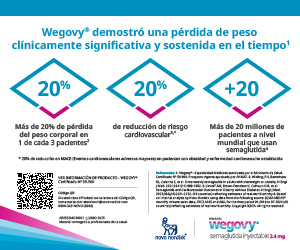Manejo del control glucémico: objetivos de tratamiento y métodos. Hemoglobina Glicosilada A1C (HbA1C). Fructosamina. Automonitoreo glucémico. Glucosuria. Cetonuria
DOI:
https://doi.org/10.47196/diab.v51i3.104Palabras clave:
objetivos de control, control metabólico, hemoglobina glicosilada A1C, automonitoreo glucémicoResumen
En la medición estándar del control y el seguimiento en pacientes con diabetes, la hemoglobina glicosilada (HbA1C) presenta dificultades en la insuficiencia renal, en la cual puede no ser buen indicador del control glucémico. La fructosamina no es válida cuando la albumina es menor a 3 mg/dl, mientras que la glucosuria y la cetonuria no son herramientas de medición efectiva en enfermedad renal. El automonitoreo glucémico (AMG) individualizado es un método útil en todos los estadios renales y el de mayor valor en el control y seguimiento en insuficiencia renal avanzada y tratamientos renales sustitutivos.
Citas
National Kidney Foundation. KDOQI. Clinical practice guidelines and clinical practice recommendations for diabetes and chronic kidney disease. A clinical update from KDIGO Kidney 2015; 87(1): 20-30
Akbari A, Clase CM, Acott P, et al. Canadian Society of Nephrology Commentary the KDIGO. Clinical practice guideline for CKD evaluation and management. Am J Kidney Dis. 2015; 65(2): 177-205.
Rohlfing CL, Wiedmeyer HM, Little RR, et al. Defining the relationship between plasma glucose and HbA(1c): analysis of glucose profiles and HbA(1c) in the Dia- betes Control and Complications Trial. Diabetes Care. 2002; 25(2):275-278.
Stratton IM, Adler AI, Neil HA, et al. Association of glycaemia with macrovascular and microvascular com- plications of type 2 diabetes (UKPDS 35): prospective observational study. BMJ. 2000; 321(7258):405-412.
American Diabetes Association. Standards of Medical Care. Diabetes Care 2017; 40 (Suppl 1): S48-S56
American Diabetes Association. Standards of Medical Care. Diabetes Care 2012; 35 (Suppl 1):S11-S63.
Munshi MN, Segal AR, Suhl E, et al. Frequent hypo- glycemia among elderly patients with poor glycemic control. Arch Intern Med 2011; 171(4):362-364.
Shurraw S, Hemmelgarn B, Lin M, et al. Association between glycemic control and adverse outcomes in people with diabetes mellitus and chronic kidney di- sease: a population based cohort study. Arch Intern Med 2011; 171: 1920-1927-
Ramirez SPB, McCullough KP, Thumma JR, et al. He- moglobin A1c levels and mortality in the diabetic he- modialysis population: finding from Dialysis Outco- mes and Practice Patterns Study (DOPPS) Diabetes Care 2012: 35:2527-2532.
Duong U, Mehrotra R, Molnar MZ, et al. Glycemic con- trol and survival in peritoneal dialysis patients with dia- betes mellitus. Clin J A Nephrol 2011; 6(5) :1041-1048.
Miller ME, Bonds DE, Gerstein HC, et al. The effects of baseline characteristics, glycaemia treatment approach, and glycated haemoglobin concentration on the risk of severe hypoglycaemia: post hoc epidemiological analy- sis of the ACCORD study . BMJ 2010; 340:b5444.
Papademetriou V, Lovato L, Doumas M, et al. Chronic kidney disease and intensive glycemic control increa- se cardiovascular risk in patients with type 2 diabetes. Kidney Int 2015; 87:649-659.
Perkovic V, Heerspink HL, Chalmers J, et al. Intensive glucose control improves kidney outcomes in patients with type 2 diabetes. Kidney Int 2013; 83(3):517-523.
Goldstein DE, Little RR, Lorenz RA, et al.Tests of glycemia in diabetes. Diabetes Care 2004; 27 (7):1761-73 2004.
Little RR, Rohlfing CL, Wiedmeyer HM, et al. The natio- nal glycohemoglobin standardization program: a five year progress report. Clin Chem 2001; 47 (11):1985-92.
Little RR, Rohlfing CL, Sacks DB; National Glycohemog- lobin Standardization Program (NGSP) Steering Com- mittee. Status of hemoglobin A1c measurement and goals for improvement: from chaos to order for impro- ving diabetes care. Clin Chem 2011; 57 (2):205-214.
Danese E, Montagnana M, Nouvenne A, et al. Advanta- ges and pitfalls of fructosamine and glyacted albumin in diagnosis and treatment of diabetes. J of Diabetes Science and Technology 2015; 9(2) 169-176.
Inaba M, Okuno S, Kumeda Y, et al; Osaka CKD Expert Research Group. Glycated albumin is a better glyce- mic indicator than glycated hemoglobin values in hemodialysis patients with diabetes: effect of anemia and erythropoietin injection. J Am Soc Nephrol 2007; 18(3):896-903.
Dagogo-Jack S. Pitffals in the use of HbA1c as a diag- nostic test: the ethnic conundrum. Nat Rev Endocrinol 2010; 6 (10):589-593.
Gallagher EJ, Le Roith D, Bloomgarden Z. Review of hemoglobin A (1c) in management of diabetes. J Dia- betes 2009; 1 (1): 9-17.
Baker JR, O’Connor JP, Metcalf PA, Lawson MR, et al. Clinical usefulness of estimation of serum fructosami- ne concentration as a screening test for diabetes melli- tus. Br Med J (Clin Res Ed) 1983 24; 287(6396):863-7.
Parrinello CM, Selvin E. Beyond HbA1c and glucose: the role of nontraditional glycemic markers in diabetes diagnosis, prognosis, and management. Curr Diab Rep 2014; 14(11):548.
Selvin E, Rawlings AM, Grams M, et al. Fructosamine and glycated albumin for risk stratification and pre- diction of incident diabetes and microvascular com- plications: a prospective cohort analysis of the Athe- rosclerosis Risk in Communities (ARIC) study. Lancet Diabetes Endocrinol 2014;2 (4):279-288.
Sumner AE, Duong MT, Aldana PC, et al. A1C combined with glycated albumin improves detection of prediabe- tes in Africans: the Africans in America study. Diabetes Care 2016;39 (2):271-277.
Mainetti H. Laboratorio en diabetes mellitus. En: Ruiz M, Ruiz-Morosini ML (Editores) Diabetes Mellitus, Vol 1, 4º Ed. Argentina Akadia; 2012, 215-218.
Poolsup N, Suksomboon N, Jiamsathit W. Systematic review of the benefits of self-monitoring of blood glu- cose on glycemic control in type 2 diabetes patients. Diabetes Technol Ther 2008; 10 (Suppl 1): S-51-S-66.
Standards of Medical Care in Diabetes, Position Sta- tement, American Diabetes Association. Diabetes Care 2008; 31(Suppl1):S12-S54.
Descargas
Publicado
Número
Sección
Licencia

Esta obra está bajo una licencia internacional Creative Commons Atribución-NoComercial-SinDerivadas 4.0.
Dirección Nacional de Derecho de Autor, Exp. N° 5.333.129. Instituto Nacional de la Propiedad Industrial, Marca «Revista de la Sociedad Argentina de Diabetes - Asociación Civil» N° de concesión 2.605.405 y N° de disposición 1.404/13.
La Revista de la SAD está licenciada bajo Licencia Creative Commons Atribución – No Comercial – Sin Obra Derivada 4.0 Internacional.
Por otra parte, la Revista SAD permite que los autores mantengan los derechos de autor sin restricciones.




























